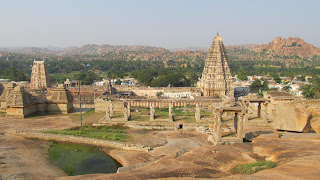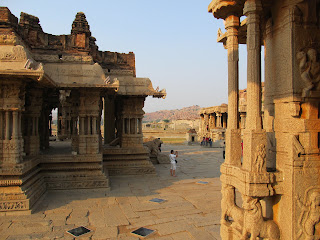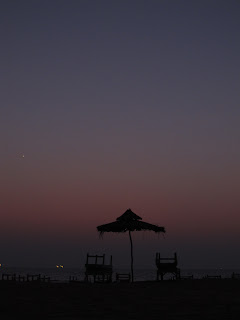 This is an old hill station favoured by the homesick wives of the British. When the heat and humidity of India became too much for these dispossessed delicates the hills beckoned. The climate and vistas are surprisingly reminiscent of home, there are meadows in which horses roam freely, and plenty of firs and pine tree woods that dominate the lake strewn hills. There is also a summer palace for the Maharaja of Mysore, which was built by the Brits for the Indian King (although it seems he was a king in name only, and it was the British who controlled his purse strings). Looking at the pictures running along the walls of its wooden grandeur, it appears to have served more as a place for the Brits to hang out and go on a jolly good elephant hunt. There are many pictures of boastful, pigeon breasted simpletons sat astride a slayed elephant seemingly, very pleased with their might.
This is an old hill station favoured by the homesick wives of the British. When the heat and humidity of India became too much for these dispossessed delicates the hills beckoned. The climate and vistas are surprisingly reminiscent of home, there are meadows in which horses roam freely, and plenty of firs and pine tree woods that dominate the lake strewn hills. There is also a summer palace for the Maharaja of Mysore, which was built by the Brits for the Indian King (although it seems he was a king in name only, and it was the British who controlled his purse strings). Looking at the pictures running along the walls of its wooden grandeur, it appears to have served more as a place for the Brits to hang out and go on a jolly good elephant hunt. There are many pictures of boastful, pigeon breasted simpletons sat astride a slayed elephant seemingly, very pleased with their might.
Ooty is about 2000m above sea level, which means that during the day it is quite warm, although tolerable to wear jeans, but at almost 4 pm precisely, the temperature plummets, sometimes close to 0. The main town isn’t much to write about, it is comparatively small, possibly about the size of Southampton centre, and it is as busy and noisy as any other growing Indian town. There, as everywhere else we have been, are remnants of the old colonial era slowly decaying behind a façade of bland, simple, modern structures, built for function rather than atmosphere. There are the rickshaws, beggars, dirt, cows and plastic that can be found anywhere else in any India town. It is the surrounds that make Ooty so spectacular, and also popular with wealthy Indian tourists (there is a surprising lack of westerners about).
We are staying near the boat house which is on a manmade lake from the mid 1800’s, which is just out of town. Surrounding it are tall fir trees that stretch far back over distant hills which sit wrapped in wispy clouds. Outside of the town, there is a constant undulating green of tea plantations and tall trees that ripple across the landscape as the hills disappear skyward. But, travelling higher into the hills, there can be seen sharp reliefs as some of the precipices fall dramatically away into the green below. The tea plantations are vast, neat little clumps of bushes, divided by walkways for the tea pickers to reach the leaves, repeated over and over across the steep hills. In the walkways the bobbing heads of women, plucking leaves and tossing them into large sacks on their backs, can be seen methodically meandering.
We have been in Ooty for over a week, and spent a few days just looking at the beautiful view of the lake from our room and enjoying a bit of peace and quiet. The days were languid and warm, with a temperate sun, the gentle sway of the trees rustled and the wind skipped a cool breeze across us. We went for a walk in the woods, and just as I was commenting that I felt we could have been in Alice Holt woods, just down the road from where we lived in Alton, when I came face to face with a couple of muscle clad beasts, which turned out to be bison. They were huge! Just stood amongst the trees munching away, until we stumbled across them. We weren’t sure what to do, are bison aggressive? Will they charge if bothered? Do they just freak like cows when approached? These were not questions that we really wanted to find answers to, and they seemed pretty jumpy, so we waited, for ages, until they wandered off and we could carry on. However, by the end of the walk, we’d seen so many of these beasts that we became quite nonchalant towards them.
The only other thing we did in Ooty was take a scooter out to look at the Nilgiri’s, the name of the hill range Ooty is in. For 4 lovely days we had beautiful weather, the day we actually decided to get off our lazy bums and do something, the cloud descended. All we saw of the breath taking views were breath freezing clouds. Every now and again one would thin out and we got a tease through a misty veil of the wonderful vistas we could have been delighted by, but mostly it was a few trees disappearing into whiteness. We also had a trek booked, but this was rained off, and we were rained in for 3/4 days. Over two of them there was a rainfall of 13 cm, 14 people died and five huge fir trees fell in the road we were staying on taking out the electricity for a few days in the entire town (apart from Domino’s who had a generator). Fortunately we were with a few other unfortunates who were also rained in so we all got drunk on local brandy and played monopoly.
We have now finally left Ooty after a rather lethargic week and a half and are headed to Kerala (we hope to find somewhere to stay for a bit there, but it may be too expensive due to a large degree of tourism). On the way we have stopped off at a place in Coimbatore, the Manchester of India, apparently, but it is not. It is much busier, noisier and grimier. However, Alex and Rob (one part of the other couple we left Ooty with) have been approached to star in an Indian film. Alex doesn’t seem so keen, so I am about to persuade him to do it………keep your eyes peeled for the new Tom Booze!!! (We went, although Alex wasn’t in the film, another guy we are travelling with was. I got really involved, it was a great fun, if not very long night.)
(I should also write about Hotel Darshan, or Hotel Headfuck as we have more aptly named it, with the oppressively friendly staff, and the fantasist mason that hobbled around it, who I suspect was one of those closet alcoholics, but it was a bit too weird.)

























